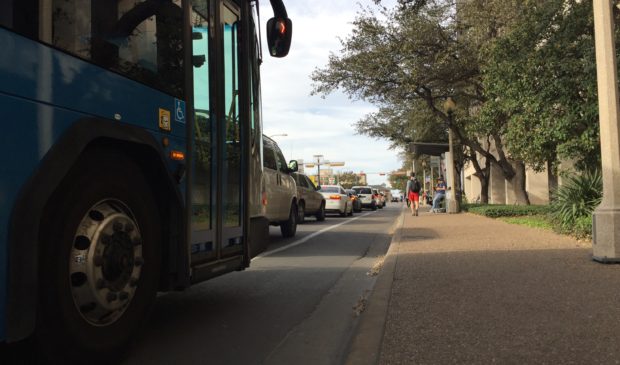UTC boosts bus lanes on the Drag
Tuesday, March 13, 2018 by
Caleb Pritchard The Urban Transportation Commission last Wednesday boosted a grassroots call on City Council to spend part of 2016’s $720 million mobility bond package on dedicated bus lanes along the congested stretch of Guadalupe Street known as the Drag.
The UTC voted 6-0 to recommend that Council include in the final Corridor Construction Program “dedicated right-of-way for transit priority or transit-exclusive lanes where they overlap with MetroRapid routes.” Short of that, the recommendation urges Council to at least alter the proposed program to include planning for those transit lanes.
While the recommendation’s language would cover stretches of Burnet Road, North Lamar Boulevard and South Lamar Boulevard where the Capital Metropolitan Transportation Authority’s two MetroRapid routes operate, the discussion at Wednesday night’s meeting was almost exclusively focused on the Drag.
When the city’s Corridor Program Office assembled the draft construction program, it reviewed recommendations from existing plans of seven major corridors. The full price of building out every recommendation easily topped $1 billion, well above the $482 million in corridor funding that voters approved in 2016. That means that staff had to cut some of the more ambitious recommendations, including a reconfiguration of the Drag to include dedicated curbside bus lanes.
Susan Somers, board president of urbanist advocacy group AURA, reminded the commission of her group’s previous findings that most travelers on the Drag during peak hours use means other than Austin’s ubiquitous single-occupant vehicles. Extending downtown’s transit priority lanes on the mile-long stretch of Guadalupe between Martin Luther King Jr. Boulevard and 29th Street, an effort AURA has long called for, is essential to improving transit operations, she said.
“This is intuitive stuff. It’s paint. It’s just paint. And it’s going to benefit everyone,” Somers said.
According to a 2016 memo written by Capital Metro staff and attached to the Guadalupe Corridor Plan, more than 14,000 bus riders travel along the Drag each weekday. Dedicating one lane on the street for transit could help buses travel through the corridor one to three minutes faster than they currently do, the memo claims, a projection it calls a “conservative estimate” based on “industry research.”
That bump could translate to an extra 850 riders each day and a savings to the agency worth between $451,000 to $1.3 million.
On Wednesday night, the only sign of dissent against the notion of giving the lanes to buses came from Commissioner Brian O’Reilly, who worried that the idea might conflict with Council’s requirement that all bond projects contribute to congestion relief.
Commissioner JD Gins answered him, “It’s a painful thing for people riding in cars, but so what? It’s moving people. That’s the goal.”
But prioritizing transit on curbside lanes might not be the slam-dunk that Somers and several commissioners framed it as. Right-turning cars would still likely be able to use the lanes, causing particular crowding for northbound buses just before Dean Keeton Street.
“That’s why we went with the conservative numbers,” Todd Hemingson, Capital Metro’s vice president of strategic planning and development, told the Austin Monitor. “We of course want the operational benefits of better, faster, more reliable service for our customers, but also we think there’s value in that kind of declaratory effect of making that public statement that (the city is) trying to prioritize transit and make more efficient use of limited right of way.”
As for the cost, the final total won’t simply be limited to the cost of painting new lanes, city officials said.
“While the materials cost to restripe lanes may be low as far as infrastructure projects go, this does not mean the process is quick,” Transportation Department spokesperson Emily Tuttle said. “The Guadalupe Corridor Plan represents up to 5 percent design, so a significant amount of design work, as well as public outreach and stakeholder coordination, would still need to take place.”
Council will get its first briefing on the proposed Corridor Construction Program during a March 20 work session. A final vote is set for Council’s regular meeting scheduled on March 22.
Photo by bigbirdz (the drag, austin, texas) [CC BY 2.0], via Wikimedia Commons.
The Austin Monitor’s work is made possible by donations from the community. Though our reporting covers donors from time to time, we are careful to keep business and editorial efforts separate while maintaining transparency. A complete list of donors is available here, and our code of ethics is explained here.
You're a community leader
And we’re honored you look to us for serious, in-depth news. You know a strong community needs local and dedicated watchdog reporting. We’re here for you and that won’t change. Now will you take the powerful next step and support our nonprofit news organization?









